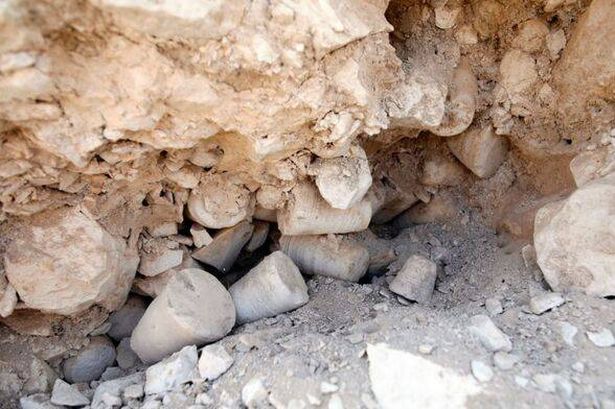Science
Archaeologists Uncover Possible Evidence of Jesus’ First Miracle

Archaeologists have made a significant discovery in the Galilean village of Cana, believed to be the site where Jesus turned water into wine, marking his first miracle. Fragments of large stone jars, similar to those described in the Gospel, were uncovered during excavations led by Israeli archaeologist Yardena Alexander. This breakthrough sheds new light on a pivotal moment in Christian history, as the miracle took place at a wedding in Cana, a location that has fascinated scholars and theologians for centuries.
Discovery Details and Archaeological Significance
The stone jar fragments were found in present-day Cana, strategically located between Capernaum and Nazareth. According to Alexander, the jars could represent the vessels mentioned in the Gospel of John, which narrates the miracle of transforming water into wine. She asserts that the archaeological evidence supports the idea that the excavation site is indeed the biblical Cana.
Yardena’s exploration began in 1999 and culminated in a rescue excavation in 2004 as construction was set to begin on the site. The excavation was partially funded by a Christian Arab family under Israeli laws governing archaeological digs. Alexander emphasized the importance of the find, stating, “We’re really working very hard to save some of this site because what we do have here is a village of Jesus. And it was here that he carried out the first miracle.”
The stone jars discovered are estimated to be between 12 and 16 inches in diameter, correlating with the measurements provided in the biblical account. Additionally, a Jewish ritual bath unearthed within the vicinity supports the theory that a Jewish community once thrived at this site. Other locally made pottery suggests that the dwelling was modest, aligning with the impoverished conditions depicted in the Scriptures.
Competing Views on the Location of Cana
While Alexander’s findings have garnered attention, the quest to definitively identify the location of biblical Cana remains contentious. American archaeologists have also claimed to uncover fragments of stone vessels at a competing site located several miles northward, arguing that they, too, may have found the biblical Cana. Archaeologist Shimon Gibson remarked on the need for caution, stating, “Just the existence of stone vessels is not enough to prove that this is a biblical site.” He noted that stone vessels are not uncommon, making it challenging to link any specific set to Jesus’ miracle.
Despite the ongoing debate, Stephen Pfann, a respected Bible scholar based in Jerusalem, acknowledged the significance of the discoveries at both locations. He stated, “I think there is ample evidence that both sites are from the first century, and we need more information to correctly identify either site.” This highlights the complexities and uncertainties surrounding the identification of biblical sites.
The miracle of turning water into wine at Cana is of profound significance among Christian theologians. It occurred during a critical time in Jesus’ early ministry, as he began to establish his reputation and attract followers. The event is seen not only as a demonstration of his divine power but also as a powerful moment in his relationship with his disciples.
As excavations continue, Yardena remains optimistic about the potential for the modern-day Cana site to evolve into a major pilgrimage destination. She believes that with additional funding and support, the site could attract tourists interested in the historical and spiritual significance of the area. The ongoing discoveries in Cana offer a glimpse into the past and a renewed interest in the life of Jesus, potentially enriching the understanding of his early ministry.
-

 Entertainment2 weeks ago
Entertainment2 weeks agoAndrew Pierce Confirms Departure from ITV’s Good Morning Britain
-

 Health4 months ago
Health4 months agoNeurologist Warns Excessive Use of Supplements Can Harm Brain
-

 Health4 months ago
Health4 months agoFiona Phillips’ Husband Shares Heartfelt Update on Her Alzheimer’s Journey
-

 Science2 months ago
Science2 months agoBrian Cox Addresses Claims of Alien Probe in 3I/ATLAS Discovery
-

 Science2 months ago
Science2 months agoNASA Investigates Unusual Comet 3I/ATLAS; New Findings Emerge
-

 Entertainment1 week ago
Entertainment1 week agoGogglebox Star Helena Worthington Announces Break After Loss
-

 Entertainment1 month ago
Entertainment1 month agoTess Daly Honoured with MBE, Announces Departure from Strictly
-

 Science2 months ago
Science2 months agoScientists Examine 3I/ATLAS: Alien Artifact or Cosmic Oddity?
-

 Entertainment3 months ago
Entertainment3 months agoLewis Cope Addresses Accusations of Dance Training Advantage
-

 Entertainment5 months ago
Entertainment5 months agoKerry Katona Discusses Future Baby Plans and Brian McFadden’s Wedding
-

 Science2 months ago
Science2 months agoNASA Investigates Speedy Object 3I/ATLAS, Sparking Speculation
-

 Entertainment5 months ago
Entertainment5 months agoEmmerdale Faces Tension as Dylan and April’s Lives Hang in the Balance









